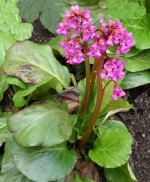
Native to Russia, this herbaceous perennial is a member of the Saxifragaceae family that also includes foam flower, coral bells, and astilbe. The plants form a rosette of shiny, heart-shaped leaves that are up to 10″ longs, leathery and turn bronze to burgundy red in the fall. In early spring, dense panicles of pink flowers appear on leafless stems up to 16″ tall. The famous garden duo, Gertrude Jekyle and Edwin Lutens, produced an outstanding design at Hestercome in England, using bergenia as an edging with lavender. The plants are often grown for the leaves alone which are attractive in borders and as groundcovers as well as in flower arrangements. The flower clusters are also good in the vase. The common name, pigsqueak, comes from the sound made when the thumb and forefinger and rubbed across a leaf. The genus name, Bergenia, honors Karl August von Bergen, 18th century professor at Frankfurt an der Oder. The specific epithet, cordifolia, comes from the Latin words cor meaning heart, and folia, meaning leaf and refers to the shape of the leaves.
Type: Herbaceous perennial.
Bloom: Pink flowers in early spring.
Size: 12-18” H x 12-18” W.
Light: Sun in North; part shade in South.
Soil: Moderately heavy, moist or dry but prefers moist.
Hardiness: Zones 3-8
Care: Low maintenance.
Pests and Diseases: Slugs, snails, vine weevils, caterpillars
Propagation: Spreads slowly by rhizomes; division in spring or fall, seed
Companion plants: Spotted dead nettle (Lamium maculatum), Siberian bugloss (Brunnera macrophylla), ferns, fringed bleeding heart (Dicentra exima).
Outstanding Selections:
‘Perfecta’ (rosy red flowers held relatively high above the foliage).
‘Purpurea’
‘Winterglut’,
‘Senior’
B. crassifolia ‘Autumn Red’.
